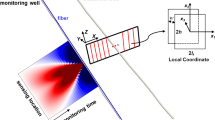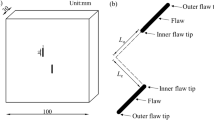Abstract
Determination of the cracking levels during the crack propagation is one of the key challenges in the field of fracture mechanics of rocks. Acoustic emission (AE) is a technique that has been used to detect cracks as they occur across the specimen. Parametric analysis of AE signals and correlating these parameters (e.g., hits and energy) to stress–strain plots of rocks let us detect cracking levels properly. The number of AE hits is related to the number of cracks, and the AE energy is related to magnitude of the cracking event. For a full understanding of the fracture process in brittle rocks, prismatic specimens of granite containing pre-existing flaws have been tested in uniaxial compression tests, and their cracking process was monitored with both AE and high-speed video imaging. In this paper, the characteristics of the AE parameters and the evolution of cracking sequences are analyzed for every cracking level. Based on micro- and macro-crack damage, a classification of cracking levels is introduced. This classification contains eight stages (1) crack closure, (2) linear elastic deformation, (3) micro-crack initiation (white patch initiation), (4) micro-crack growth (stable crack growth), (5) micro-crack coalescence (macro-crack initiation), (6) macro-crack growth (unstable crack growth), (7) macro-crack coalescence and (8) failure.

















Similar content being viewed by others
References
Andersson C, Martin CD, Stille H (2009) The Äspö pillar stability experiment: part II—rock mass response to coupled excavation-induced and thermal-induced stresses. Int J Rock Mech Min Sci 46(5):865–878
Bieniawski ZT (1967a) Mechanism of brittle fracture of rock, part I—theory of the fracture process. Int J Rock Mech Min Sci Geomech Abstr 4(4):395–406
Bieniawski ZT (1967b) Mechanism of brittle fracture of rock, part II—experimental studies. Int J Rock Mech Min Sci Geomech Abstr 4(4):407–423
Bobet A, Einstein HH (1998) Fracture coalescence in rock-type materials under uniaxial and biaxial compression. Int J Rock Mech Min Sci 35(7):863–888
Brace WF (1964) Brittle fracture of rocks. In: Judd (ed) State of Stress in the Earth’s Crust. American Elsevier Publishing Co, New York, pp 111–180
Brace WF, Paulding B, Scholz C (1966) Dilatancy in the fracture of crystalline rocks. J Geophys Res 71:3939–3953
Brooks Z, Ulm F-J, Einstein HH (2013) Environmental scanning electron microscopy (ESEM) and nanoindentation investigation of the crack tip process zone in marble. Acta Geotech 8(3):223–245
Damjanac B, Fairhurst C (2010) Evidence for a long-term strength threshold in crystalline rock. Rock Mech Rock Eng 43(5):1–19
Diederichs MS (2007) The 2003 Canadian Geotechnical Colloquium: mechanistic interpretation and practical application of damage and spalling prediction criteria for deep tunneling. Can Geotech J 44:1082–1116
Diederichs MS, Kaiser P, Eberhardt E (2004) Damage initiation and propagation in hard rock during tunneling and the influence of near-face stress rotation. Int J Rock Mech Min Sci 41(5):785–812
Eberhardt E, Stead D, Stimpson B, Read R (1998) Identifying crack initiation and propagation thresholds in brittle rocks. Can Geotech J 35(2):222–233
Goldsmith W, Sackman JL, Ewert C (1976) Static and dynamic fracture strength of Barre Granite. Int J Rock Mech Min Sci Geomech Abstr 13:303–309
Griffith AA (1921) The phenomena of rupture and flow in solids. Phil Trans R Soc Lond A 221:163–197
Lajtai EZ (1974) Brittle fracture in compression. Int J FractMech 10:525–536
Lavrov A (2003) The Kaiser effect in rocks: principles and stress estimation techniques. Int J Rock Mech Min Sci 40(2):151–171
Lockner D (1993) The role of acoustic emission in the study of rock fracture. Int J Rock Mech Min Sci Geomech Abstr 30:883–899
Martin CD, Chandler NA (1994) The progressive fracture of Lac du Bonnet granite. Int J Rock Mech Min Sci Geomech Abstr 31(6):643–659
Martin CD, Christiansson R (2009) Estimating the potential for spalling around a deep nuclear waste repository in crystalline rock. Int J Rock Mech Min Sci 46:219–228
Miller JT (2008) Crack coalescence in granite. MSc Thesis, Massachusetts Institute of Technology
Miller JT, Einstein HH (2008) Crack coalescence tests on granite. In: The 42nd U.S. Rock mechanics symposium (USRMS), San Francisco, 29 June–2 July 2008
Morgan SP, Johnson CA, Einstein HH (2013) Cracking processes in Barre granite: fracture process zones and crack coalescence. Int J Fract 180(2):177–204
Nicksiar M, Martin CD (2012) Evaluation of methods for determining crack initiation in compression tests on low-porosity rocks. Rock Mech Rock Eng 45(4):607–617
Nicksiar M, Martin CD (2014) Factors affecting crack initiation in low porosity crystalline rocks. Rock Mech Rock Eng 47(4):1165–1181
Rojat F, Labiouse V, Kaiser PK, Descoeudres F (2009) Brittle rock failure in steg lateral adit of the lötschberg base tunnel. Rock Mech Rock Eng 42:341–359
Seto M, Nag DK, Vutukuri VS (1999) In-situ rock stress measurement from rock cores using the acoustic emission method and deformation rate analysis. Geotech Geol Eng 17(3–4):241–266
Stacey TR (1981) A simple extension strain criterion for fracture of brittle rock. Int J Rock Mech Min Sci Geomech Abstr 18:469–474
Waversik WR, Fairhurst C (1970) A study of brittle rock fracture in laboratory compression experiments. Int J Rock Mech Min Sci 7:561–575
Wong LNY, Einstein HH (2009a) Crack coalescence in molded gypsum and Carrara marble: part 1-macroscopic observations and interpretation. Rock Mech Rock Eng 42(3):475–511
Wong LNY, Einstein HH (2009b) Crack coalescence in molded gypsum and carrara marble: part 2-microscopic observations and interpretation. Rock Mech Rock Eng 42(3):513–545
Xia K, Nasseri MHB, Mohanty B, Lu F, Chen R, Luo SN (2008) Effects of microstructures on dynamic compression of Barre granite. Int J Rock Mech Min Sci 45:879–887
Acknowledgments
The research was supported financially through a Collaborative Research and Development Grant from Natural Sciences and Engineering Research Council of Canada and Hydro-Quebec. The authors would also like to thank Université de Sherbrooke for providing the AE equipment.
Author information
Authors and Affiliations
Corresponding author
Rights and permissions
About this article
Cite this article
Moradian, Z., Einstein, H.H. & Ballivy, G. Detection of Cracking Levels in Brittle Rocks by Parametric Analysis of the Acoustic Emission Signals. Rock Mech Rock Eng 49, 785–800 (2016). https://doi.org/10.1007/s00603-015-0775-1
Received:
Accepted:
Published:
Issue Date:
DOI: https://doi.org/10.1007/s00603-015-0775-1




